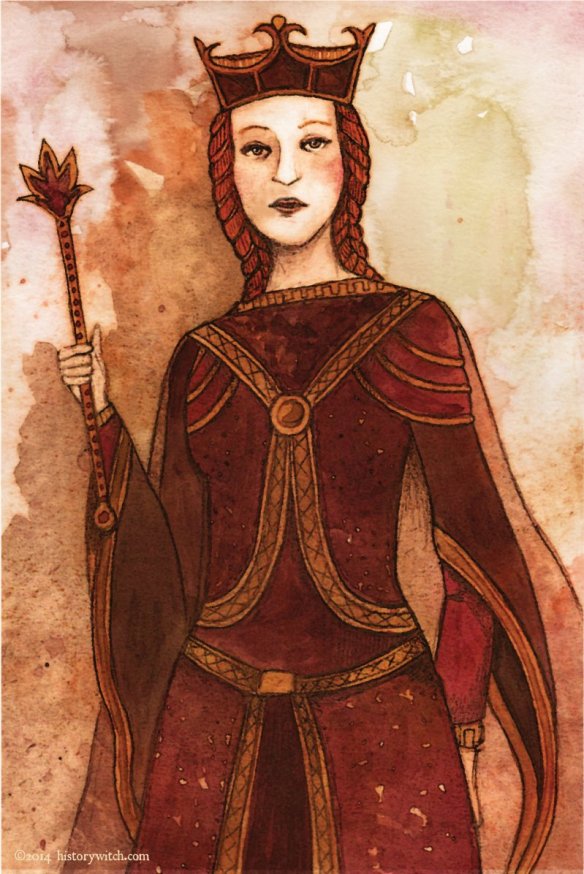Frankish Empresses, fl. 567–613 and 549–597, respectively
Chiefly remembered for her hideous death, Brunhilde deserves more credit for her long and power-packed life. As warrior queen and stateswoman, she displayed indomitable courage and formidable skill through forty years of continuous war. Thrown into the bear pit of Frankish politics as a young bride, she ruled until she was regent for her great-grandchildren, and was almost eighty years of age when she died.
Her lifelong rival and mortal enemy, Fredegund, the Lady Macbeth of the Dark Ages, achieved power through her husband and used it to keep his kingdom in a state of war for more than forty years. One of the most bloodthirsty and sadistic women in history, she spent a lifetime stirring up old conflicts and creating new ones throughout the vast empire of the Franks, a territory covering most of modern Europe. Always ready for open aggression, Fredegund was also an early exponent of dirty warfare and relied heavily on poison and other covert operations to dispatch her foes.
Fredegund’s career as a psychopath began humbly enough, as a slave girl at the court of the depraved and vicious Frankish emperor Chilperic, whose kingdom comprised most of northern France. Fredegund caught Chilperic’s eye, became his mistress, and persuaded him to set his wife aside and later to have her killed. The oldest of four brothers who had carved up the vast empire of their father, the powerful Chlotar I, at his death in 561, Chilperic was always at odds with his siblings, above all his youngest brother Sigebert, who held the kingdom next to his.
Brunhilde’s tragedy lay in her entanglement with these warring brothers as soon as she was old enough to marry. A Spanish princess christened Bruna, the daughter of the king of the Visigoths, she was noted for her intelligence and beauty from an early age, and in 568 she was married to Sigebert, ruler of the eastern Frankish kingdom that covered most of modern Germany.
Her father the king then sought another union with the Franks. Chilperic had already murdered one queen at the instigation of his slave mistress, Fredegund, but despite his vicious reputation, Brunhilde’s sister Galswintha was forced into marriage with him.
The marriage did not last. Brunhilde soon learned that her sister was dead. Fredegund had persuaded Chilperic to have Galswintha strangled in her bed, only to marry the less-than-grief-stricken widower herself a few days later.
With her husband’s help, Brunhilde made war upon the murderous couple. In early engagements, Chilperic was defeated by Sigebert, but Fredegund turned the tables in 575 when she hired assassins to stab Sigebert to death. Brunhilde was captured but set free by Chilperic’s son Meroveus, who fell in love with her. In revenge, Fredegund hounded Meroveus to his death.
Returning to her own kingdom, Brunhilde found herself at war again. Her young son was now established on Sigebert’s throne, and Brunhilde took up the reins of power on his behalf. The rule of a woman was anathema to a strong political party of noblemen, who raised an army against her. Brunhilde appealed for peace, but in a grim foreshadowing of her eventual fate, she was warned, “Depart from us, lest our horses’ hooves trample you underfoot.” Undeterred, Brunhilde led her forces into battle and won the day. Confirmed in power, she was able to rule openly on behalf of her still-youthful son, Childebert.
At Childebert’s majority, Brunhilde stepped down. Meanwhile the war with Fredegund dragged on, and Brunhilde’s son and his wife were poisoned, most probably on the orders of the wicked queen. Brunhilde took up arms again to govern on her grandsons’ behalf, making them and herself once again the target of Fredegund’s uncontrollable rage. Fredegund’s lust for power only deepened in 584 when she had her own husband murdered and began to rule in her own right, posing as regent for her young son, Chlotar II.
Brunhilde and her grandsons were now in constant danger of assassination, as Fredegund made more than one attempt to have them poisoned. She was still directing both open and dirty warfare, involving her favorite weapons of knife and poison, when she died unexpectedly in 597, leaving her kingdom to her equally cruel and murderous son, Chlotar II.
The threat from Fredegund had ceased. But Brunhilde’s wars were not over. Her former enemies among the Frankish nobles now persuaded the older of her two grandsons to seize power and to banish her. With the aid of the younger brother, Brunhilde fought back, mounting a successful military operation in which her opponent was defeated and killed. But her success was short-lived. Her victorious grandson died suddenly at the age of twenty-six, leaving four young sons.
Approaching seventy years of age, Brunhilde found herself regent again, this time for her great-grandchildren, but was no longer able to contain the rapacious ambition of her noblemen. Her enemies turned in secret to Fredegund’s son, Chlotar II, and offered him the kingdom if he would remove the queen.
Chlotar accepted. Betrayed by the leader of her own party, Brunhilde was handed over to her former rival’s equally depraved and cruel son. Accounts of her death vary, but all agree that she was subjected to three days of appalling humiliation and torture before Chlotar and all his army, and finally torn to pieces by wild horses.
Reference: Gregory of Tours and Lewis Thorpe, A History of the Franks, 1976.
